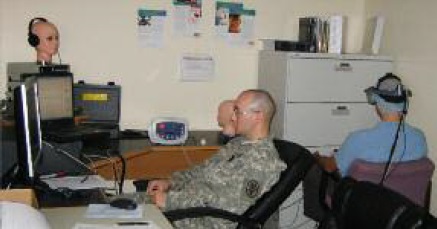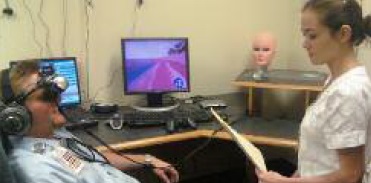➣ By Melba C. Stetz et al.

Figure 1.Mental Health Specialist (SGT Meyers) simultaneously monitor (a) what a participant sees via an HMD as well as (2) his stress marker’s levels.
The National Institute of Mental Health reports that over five million individuals in the United States suffer annually from stress. In 2007, the American Psychological Association conducted a survey study. Specifically, many participants reported experiencing psychological symptoms related to stress as anger (50 %), nervousness (45 %). low energy (45 %), and wanting to cry (35 %). It is also estimated that stress in the form of posttraumatic stress disorder, for example, impacts 3-15% of deployed war fighters involved in the current conflicts. About one out of every 10 veterans from Operation Iraqi Freedom/ Operation Enduring Freedom (OIF/OEF) might suffer some type of stress disorder. Coming back from the battle-zone with a combat-stress diagnosis might facilitate access-to-care and potential financial benefits. In fact, a study on OIF veterans suggested that about one-third of those that received care from 2001 to 2005 were diagnosed with general mental health or psychosocial problems. That said, being diagnosed with combat stress problems also involves a spillover of other problems that impact the readjustment to life out of the battle-zone.
Mental Health help in the Battlezone
The U.S. military is currently a voluntary force. Some individuals join to follow a family tradition, to seek an adventure, to show patriotism, such as joining after 9/11, and even to avoid jail. Nevertheless, the U.S. military can be a very stressful organization. It imposes rigid rules and expectations. The rationale behind this modus operandi is that, in the moment of truth, an automatic “right” decision can make the difference between life or death.
Psychotherapy can have positive outcomes for a war fighter, but also casts a shadow of negative social outcomes. War fighters who experience combat stress symptoms such as hypervigilance and nightmares end up without many options. They can live in denial trying to avoid their worst memories, or seek help. If a warrior wants help, she or he will likely have to ask supervisors for time to see a doctor, making public their inner feelings of vulnerability.
In the battle-zone, this truth can be even worse. A war fighter identified as “having mental problems” will probably have to be removed from the battle-zone if not treated on site. If treated on site, she or he might restricted from carrying a weapon. The individual might be asked to do things differently from peers, such as sleep in a specific area under supervision, remove the bolt from the weapon or other actions. In addition to the potential stigma, getting psychological help is a “luxury.” There are not enough mental health providers or vehicles to take patients back and forth from sessions or meetings.
While deployed to OIF, the author, Stetz, surveyed deployed warriors to learn that their preferred forms of relaxation were listening to music (65%), watching movies (62%), and playing computer games (39%). In consonance with previous studies, these individuals reported preferring to chat with peers, chaplains, and military leaders about personal difficulties rather than go to therapists.

Figure 2. Research Assistants (Koliani and McDermott) test one of the VR systems to be used during a cystoscopy session.
Therapies for the Digital Generation of Warriors
One of the preferred methods to help war fighters in distress involves cognitive-behavioral therapeutic approaches. A prized technique is called “imaginal” exposure. Patients repeatedly imagine their worst traumatic event(s) in therapy to habituate to the mental and emotional experience. The pairing of autonomic arousal with recounting of stressful memories is then followed by relaxation, with the hope that reduction of associated psychosocial impairments will be mitigated. Another technique is called “in vivo” exposure. In these sessions, individuals are placed in situations that they find stressful, such as facing a crowded marketplace. Most clinicians add positive coping strategies in the form of progressive muscular relaxation and controlled breathing in these sessions. The goal with these approaches is to help the client to re-engage in their daily living activities. Nevertheless, imaginal exposure cannot be effective if the patient has problems imagining things. Similarly, while in vivo exposure does not depend on imagination, it can risk further distress when exposing clients to situations that they want to avoid.
Interestingly, the U.S. Army has recently released a new Field Manual “Training for Full Spectrum Operations.” This manual explicitly references technology and gaming as a needed military tool. Considering the stigma that war fighters and shortcomings with current therapeutic approaches, virtual reality (VR) seems to be a keystone point between all roads. That is, there is no need to depend directly upon imagination or to risk exposing a patient to a traumatic stressor. It can also present immersive environments that can be experienced simultaneously by both the therapist/researcher and the individual in need. Furthermore, stimuli can be presented within a measured and successive manner to suit treatment goals.

Figure 3. Research Fellow Ries (author), and RA Kaloi- Chen testing the VR system and relaxation script for a chronic pain session.
Virtual Reality at Tripler Army Medical Center
Tripler Army Medical Center’s Department of Psychology is considered a “Center of Excellence in Professional Psychology” servicing the Pacific Region. It offers psychology services to help the local community and offers top-rated training experiences to develop the new generation of mental health professionals. Considering the above-mentioned stigma experienced by many war fighters and their attraction to computers and videogames, this department has launched several VR clinical research projects.
Preliminary data from one of these VR studies (see Figure 1) suggests deeper immersion when wearing a head mounted display (HMD). That is, participants that watched videos of angry bosses yelling at them had higher levels of subjective “presence” and emotional reactivity than those watching the videos on a flat screen. In another study, anecdotal data suggests effective pain distraction by VR for the urology patients that played a videogame while wearing a HMD (Figure 2). Similarly, chronic pain patients involved with another study are reporting more distraction/ immersion when using HMDs to play a relaxing game while listening to relaxation scripts (Figure 3).
As evidenced by studies such as these, embracing the values presented by VR mental health technology can unfurl a wide range of possibilities, offering broader access to self-care adjuncts and psychotherapy tools. New explorations of applications for VR in mental health portend fruitful growth in psychologyrelated fields and new frontiers for individuals’ healing.
MAJ Melba C. Stetz, Ph.D.
Richard I. Ries, MSEd
Raymond A. Folen, Ph.D.
Department of Pyschology
Tripler Army Medical Center
U.S.A.
Melba.Stetz@us.army.mil
www.tamc.amedd.army.mil/offices/Psychology/research.html
About Brenda Wiederhold
President of Virtual Reality Medical Institute (VRMI) in Brussels, Belgium.
Executive VP Virtual Reality Medical Center (VRMC), based in San Diego and Los Angeles, California.
CEO of Interactive Media Institute a 501c3 non-profit
Clinical Instructor in Department of Psychiatry at UCSD
Founder of CyberPsychology, CyberTherapy, & Social Networking Conference
Visiting Professor at Catholic University Milan.







